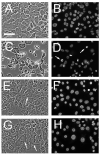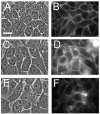Effects of endosomal photodamage on membrane recycling and endocytosis
- PMID: 21208213
- PMCID: PMC3076528
- DOI: 10.1111/j.1751-1097.2011.00890.x
Effects of endosomal photodamage on membrane recycling and endocytosis
Abstract
The flux of receptor-independent endocytosis can be estimated by addition of wortmannin to cell cultures. Membrane influx is unaffected but traffic out of late endosomes is impaired, resulting in a substantial enlargement of these organelles. Using the 1c1c7 murine hepatoma, we investigated the effect of endosomal photodamage on this endocytic pathway. We previously reported that photodamage catalyzed by the lysosomal photosensitizer NPe6 prevented wortmannin-induced endosomal swelling, indicating an earlier block in the process. In this study, we show that endosomal photodamage, initiated by photodamage from an asymmetrically substituted porphine or a phthalocyanine also prevents wortmannin-induced endosomal swelling, even when the photodynamic therapy (PDT) dose is insufficient to cause endosomal disruption. As the PDT dose is increased, endosomal breakage occurs, as does apoptosis and cell death. Very high PDT doses result in necrosis. We propose that photodamage to endosomes results in alterations in the endosomal structure such that influx of new material is inhibited and receptor-independent endocytosis is prevented. In an additional series of studies, we found that the swollen late endosomes induced by wortmannin are unable to retain previously accumulated fluorescent probes or photosensitizers.
© 2011 The Authors. Photochemistry and Photobiology © 2011 The American Society of Photobiology.
Figures








References
-
- Ouédraogo G, Morlière P, Mazière C, Mazière JC, Santus R. Alteration of the endocytotic pathway by photosensitization with fluoroquinolones. Photochem. Photobiol. 2000;72:458–463. - PubMed
-
- Olchawa M, Szewczyk G, Zareba M, Pilat A, Bzowska M, Mikolajczyk T, Sarna T. Sub-lethal Photodynamic Damage to ARPE-19 Cells Transiently Inhibits Their Phagocytic Activity. Photochem. Photobiol. 2010;86:772–780. - PubMed
Publication types
MeSH terms
Substances
Grants and funding
LinkOut - more resources
Full Text Sources
Medical
Research Materials

